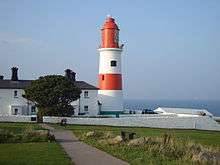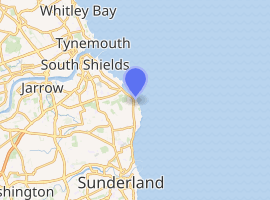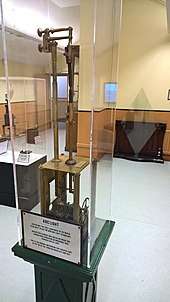Souter Lighthouse
Souter Lighthouse (grid reference NZ408642) is a lighthouse located in the village of Marsden in South Shields, Tyne & Wear, England. Souter was the first lighthouse in the world to be actually designed and built specifically to use alternating electric current, the most advanced lighthouse technology of its day. First lit in the 1870s, Souter was described at the time as 'without doubt one of the most powerful lights in the world'.[2]
 Souter Lighthouse | |
 Tyne and Wear | |

| |
| Location | Marsden Tyne and Wear England |
|---|---|
| Coordinates | 54.970503°N 1.364100°W |
| Year first constructed | 1871 |
| Deactivated | 1988 |
| Construction | brick tower |
| Tower shape | cylindrical tower with balcony and lantern |
| Markings / pattern | white tower with a horizontal red band, red lantern |
| Tower height | 77 ft (23 m) |
| Original lens | 2nd & 3rd order revolving catadioptric |
| Current lens | revolving 1st order bi-form catadioptric |
| Range | 26 nmi (48 km; 30 mi) |
| Characteristic | Fl R 5s. |
| Fog signal | One blast every 30s |
| Admiralty number | A2694 |
| ARLHS number | ENG-127 |
| Managing agent | National Trust[1] |
| Heritage | Grade II* listed building or structure |
Location
The lighthouse is located on Lizard Point, but takes its name from Souter Point, which is located a mile to the south. This was the intended site for the lighthouse, but it was felt that Lizard Point offered better visibility, as the cliffs there are higher, so the lighthouse was built there instead. The Souter Lighthouse name was retained in order to avoid confusion with the then recently-built Lizard Lighthouse in Cornwall.
Souter Lighthouse is approximately three miles south of the mouth of the River Tyne. Some four miles or so to the north of the mouth of the Tyne is a sister Victorian lighthouse, St Mary's Lighthouse, on St Mary's Island. This has now been decommissioned, but is open to visitors. St Mary's Lighthouse can be seen with the naked eye from the top of Souter Lighthouse.[3]
History
The lighthouse was a much-needed aid to navigation due to the number of wrecks on the dangerous reefs of Whitburn Steel[4] which lay directly under the water in the surrounding area. In one year alone – 1860 – there were 20 shipwrecks. This contributed to making this coastline the most dangerous in the country, with an average of around 44 shipwrecks per every mile of coastline.
19th century
Construction
Designed by James Douglass it was opened in 1871, with construction supervised by civil engineer Henry Norris[5] for Trinity House. The contract for building the lighthouse and keeper's cottage was reported in March 1869 as being £8,000[6] and was awarded to the local firm of James Todd,[7] after complaints that local builders had not had the opportunity to reply to tender as it had not been advertised locally.[8] The foundation stone was ceremonially laid by Admiral Collinson's sister on 9 June 1869.[9] After completing this project Douglass and Norris moved on to the building of Hartland Point Lighthouse in Devon.
Electricity

Trinity House had carried out an extensive testing and selection process over five years and included comparison with oil lights and examination of equipment in Britain and France.[10]
The 800,000 candle power light was generated using carbon arcs and not an incandescent light bulb, and could be seen for up to 26 miles.[11] The optics were designed and built by James Chance in 1870.[12] The main lens array consisted of a third-order fixed catadioptric optic surrounded by a revolving assembly of eight vertical condensing-prisms which produced one flash every minute.[2]
In addition to the main light a red/white sector light shone from a window in the tower below the lantern, to highlight hazardous rocks to the south; it was powered using light diverted (through a set of mirrors and lenses) from the landward side of the main arc lamp.[13]
Carbon arc lights for lighthouses were pioneered by Professor Frederick Hale Holmes with experiments in (1857-60) at Blackwell and South Foreland Lighthouse off the Kent coast (described in a lecture [14] by Michael Faraday at the Royal Institution) and a test installation at Dungeness in 1862 and complete installation at Souter in 1870.[15] Electricity was provided by two of Holmes' own magneto electric generators for which he took out a series of patents[16] during those years. One of the Holmes generators built in 1867 and used at Souter is now on display at the Science Museum, London.[17] The generators were driven by one of a pair of 3 hp steam engines,[2] located in the engine-house, which also drove an air-pump to feed the pressure tank of a foghorn.[18] (The engines were worked alternately: one week on, one week off.)
Charts and Engineering (1875)
_p163_-_Plate_XV._Souter_Point%2C_east_elevation.jpg) East Elevation
East Elevation_p157_-_Plate_XIII._Souter_point%2C_ground_plan.jpg) Ground plan
Ground plan_p151-_Plate_XI._Souter_Point%2C_plan_of_machine-room.jpg) Machine room
Machine room_p161_-_Plate_XIV._Souter_Point%2C_section_of_lantern%2C_lens%2C_and_low_light-room.jpg) Light room
Light room_p154_Fig.11_-_Lens_and_lanterns%2C_Sonter_Point.jpg) Lens and Lanterns
Lens and Lanterns_p145_-_Plate_IX._Souter_Point%2C_chart_of_vicinity.jpg) Chart of vicinity (1875)
Chart of vicinity (1875)
20th century

In 1914 the pioneering electric light at Souter was replaced with more conventional oil lamps. At the same time Chance Brothers provided a new, much larger bi-form first-order catadioptric revolving optic, which remains in situ in the tower; as a bi-form lens it is double-height, containing two lamps, one above the other. (A separate lamp was used for the sector light, lower down in the tower).
In 1952 the lighthouse was again converted to run on (mains) electric power.[11] The mechanism which caused the optic (lens array) to revolve was driven by clockwork until 1983.[19]
Souter Lighthouse was decommissioned in 1988,[20] but continued to serve as a radio navigation beacon up until 1999 when it was finally closed.
Present day
As Souter was never automated, it remains much in its original operational state except for updates during its lifespan to its lantern and electrical apparatus.
Today the decommissioned Souter lighthouse is owned by the National Trust and open to the public; the engine room, light tower and keeper's living quarters are all on view. There is also an outdoor play area, Trusty Club and indoor activities to accommodate young visitors. Two of the former lighthouse keepers' cottages are used as National Trust holiday cottages. The lighthouse is said to be haunted, and has even featured on British TV's Most Haunted ghost-hunting programme.[21]
Foghorn

The original fog signal at Souter was a pair of Holmes-designed reeds, housed in a foghorn house to the east of the lighthouse tower; it sounded one blast every 45 seconds from a pair of twin horns facing out to sea, angled north-east and south-east.[22] Compressed air was piped to the foghorn from the engine room alongside the lighthouse, where the air compressor was driven by a common drive shaft from the engines powering the magnetos.[18] A siren replaced the reeds in February 1879.[22] The horns were superseded by twin Rayleigh trumpets in 1919, when a more powerful siren was installed; the foghorn house was remodelled at the seaward corners to accommodate them. The siren signal was a 5-second sound of 480 Hz every 5 minutes.
The current pair of exponential horns dates from 1953, when a Stone Chance diaphone signal was installed. This produced a five-second blast every 30 seconds in poor weather, up until 1988 when Souter Lighthouse was decommissioned by Trinity House. The diaphone remains in working order and is sounded regularly for visitors throughout the year.
References
- Souter The Lighthouse Directory. University of North Carolina at Chapel Hill. Retrieved 26 April 2016
- Elliot, George H. (1875). European Light-House Systems. London: Lockwood & co. pp. 120–127. Retrieved 10 March 2019.
- Personal observation
- "Newcastle Courant". 18 June 1869. p. 6.
a new lighthouse to be erected on Souter Point...It will erected to prevent wrecks from occurring, if possible, on Whitburn Steel, of which there have been so many complaints within recent years.
- "Shields Gazette and Daily Telegraph". 9 September 1870. p. 3.
the works are being pushed rapidly forward under the supervision of Mr H. Norris, the board and resident engineer
- "Sheffield Daily Telegraph". 11 March 1869. p. 2.
A new lighthouse and keepers' residence are to erected at Souter Point near, South Shields. The contract for building has been let for £8,000.
- "The Architect and Contract Reporter: A Weekly Illustrated Journal". 1. January–June 1869: 183.
The contract for the erection of a new lighthouse and lighthouse-keepers residence at Souter Point, near Sunderland, has been let to Mr. Todd, builder, of South Shields, for £8,000
Cite journal requires|journal=(help) - "Shields Gazette and Daily Telegraph". 12 April 1869. p. 2.
Some months ago, tenders were advertised for in the Sunderland papers, asking offers for the erection of a lighthouse on Souter Point. Most of the people in Shields hardly ever saw a Sunderland paper in their lives, yet the Shields builders were virtually shut out from competing for a lighthouse within the limits of their own Poor-Law Union, so far as publicity of the fact of tenders being wanted was concerned. Communications were accordingly made from this office on the subject; the advertisement appeared in the Gazette, and a South Shields contractor ultimately got the job.
- "Shields Gazette and Daily Telegraph". 9 June 1869. p. 9.
The foundation-stone of the lighthouse at Souter Point was laid yesterday afternoon by Mrs Blain (sister to Admiral Collinson) in the presence of the committee of the Elder Brethren of the Trinity House, London, Admiral Collinson, Captain Nesbitt, Captain Webb, Mr G. N. Douglas[sic], engineer to the Corporation, and friends. Robert [sic] Norris is the superintendent of the works, and Mr James Todd is the contractor.
- "Dover Express". 22 May 1868. p. 4.
- Jones, Robin (2014). Lighthouses of the North East Coast. Wellington, Somerset: Halsgrove.
- Chance, James Frederick (1902). The Lighthouse Work of Sir James Chance, Baronet (PDF). London: Smith, Elder & co. p. 166. Retrieved 24 February 2019.
- "Trinity House History page, quoting Newcastle Courant 12 Jan. 1871".
- "Newcastle Courant". 30 March 1860. p. 3.
MAGNETO-ELECTRIC LIGHT FOR LIGHTHOUSES - Professor Faraday, in a lecture delivered at the Royal Institution, says: "By means of a magnet, and of motion, we can get the some kind of electricity as from the battery; and, under the authority of the Trinity House, Professor Holmes has been occupied in introducing the magneto-electric light in the lighthouse at the North [sic] Foreland...For the last six months the North [sic] Foreland has been shining by means of this electric light beyond all comparison better than its former light. Never for once during six months has it failed in doing its duty
- Electricity Supply in the United Kingdom - A Chronology from the beginnings of the Industry to 31 December 1985 (4th ed.). The Electricity Council. 1987 [1973]. p. 15. ISBN 0-85188-105-X.
- Biographical Dictionary of the History of Technology. Routledge. 1996. p. 606. ISBN 0-415-06042-7.
- "Holmes's electricity generator, 1867". Retrieved 4 November 2013.
- Renton, Alan (2001). Lost Sounds: The Story of Coast Fog Signals. Caithness, Scotland: Whittles.
- "Local history society".
- http://www.chroniclelive.co.uk/news/local-news/ten-interesting-facts-south-shields-1342148
- http://www.tv.com/shows/most-haunted/souter-lighthouse-282470/
- "Fog Signals". Parliamentary Papers, volume LXIV. 23 (337): 2–4. 1 August 1879.
External links
| Wikimedia Commons has media related to Souter Lighthouse. |
